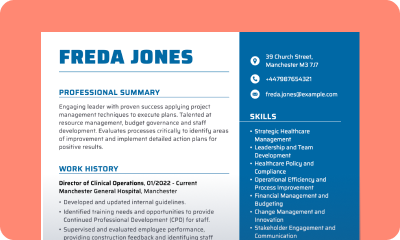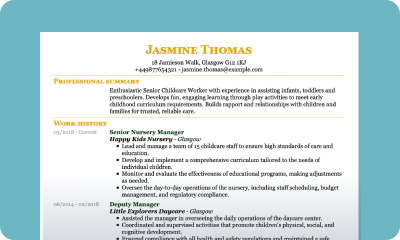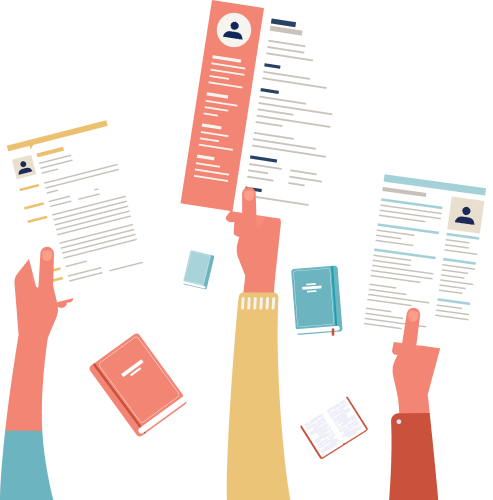How Far Back Should a CV Go? Here’s What Works Best
You’ve got years of experience — but how much of it actually belongs on your CV? It’s a tricky balance to strike. Hiring managers have limited time, and long CVs filled with old roles often get overlooked. If you’re wondering how far back should a CV go, you’re in the right place.


Our customers have been hired by: *Foot Note
How far back should a CV go? (the quick answer)

If you’ve ever wondered how far back should a CV go, here’s the short answer: your CV should usually cover the last 10 to 15 years of your career history.
That’s the sweet spot most hiring managers expect. It gives them a clear view of your most relevant and recent achievements without overwhelming them with older, less important details. For early-career professionals, that might mean just a few years of experience — and that’s perfectly fine. For senior or technical professionals, going up to 15 or even 20 years is acceptable if those earlier roles still add value.
The key is to focus on what’s most relevant now, not everything you’ve ever done. Recruiters spend only seconds scanning each CV, so you want your most impactful experience front and centre.
Why is 10–15 years the ideal range for a CV?
So, why does everyone talk about the 10–15-year rule when it comes to CVs? It’s not a random number; it’s based on how hiring works today and what recruiters actually look for.
Recruiters want to see your most recent work experience. Those give them the clearest sense of what you can offer right now. Over time, your skills, industry knowledge, and responsibilities evolve — which means older experience often doesn’t represent your current level or expertise.
Keeping your CV focused on the past decade helps you:
- Showcase your most up-to-date experience. Employers care about what you’re doing now, not what you did two decades ago.
- Keep your CV concise and readable. A focused document is easier to scan — and that’s crucial when recruiters spend just a few seconds reviewing each one.
- Highlight your career progression. Ten years is usually enough to demonstrate growth, promotions, and key achievements.
- Avoid age-related bias. Trimming very old roles can keep your CV modern and aligned with current career goals.
Why you shouldn’t include your entire work history on your CV

It’s tempting to list every job you’ve ever had — especially if you’ve worked hard to build your career. But a CV isn’t meant to be a full autobiography; it’s a targeted snapshot of your most relevant experience. Including too many years of work experience can actually make your CV less effective.
Recruiters and hiring managers spend very little time on each application — often just 6 to 10 seconds before deciding whether to keep reading. A CV that’s too long, or filled with older, less relevant roles, makes it harder for them to spot your key strengths quickly.
The truth is, most employers care about what you’ve done recently, not what you did two decades ago. Your most current roles show the skills, tools, and results that matter right now. The earlier parts of your career, while important to you, rarely influence a hiring decision at this stage.
Instead of trying to fit your entire work history into one document, think strategically:
- Keep your CV focused on the past 10 to 15 years of strong, relevant experience. Ideally your CV should be no more than 2 pages.
- Summarise older roles briefly if they add context or credibility.
- Use your LinkedIn profile to show your complete employment timeline. Recruiters who want a deeper dive into your career can find that information there.
This approach gives you the best of both worlds: a focused CV that gets attention quickly, and a comprehensive LinkedIn profile that tells your full professional story.
Remember: your CV is a highlight reel, not a documentary. The aim isn’t to show everything you’ve done, but to make it easy for employers to see why you’re perfect for the job you want now.
How to trim your CV

Cutting down your CV can feel discouraging — especially when every role feels like it tells part of your story. But trimming isn’t about removing value; it’s about refining focus. A well-edited CV highlights your best experience, shows a clear career trajectory, and makes it easy for recruiters to see why you’re the right fit.
1. Focus on relevance, not history
Start by reviewing each role and asking: Does this job demonstrate skills or results that matter for the position I want now? If not, summarise or remove it. Relevance beats longevity every time.
2. Summarise older roles
You don’t need to delete your older experience altogether, but there’s no need to go into detail either. Simply list the job title, company name, and dates of employment, without adding bullet points about duties or achievements. This approach keeps your CV concise while showing a more complete work history.
3. Emphasise achievements, not duties
Recruiters are more interested in what you accomplished than what you were responsible for. Use short, results-driven bullet points to highlight measurable outcomes — such as growth figures, project completions, or performance improvements.
4. Use a CV template that’s clean, structured, and space-efficient
Even a well-written CV can fall flat if it looks cluttered. A consistent layout helps your experience shine and makes it easier for recruiters to find key details quickly. My Perfect CV’s CV templates are built to fit a lot of information without looking crowded, giving you plenty of room to include your work history in a clean, structured format that stays professional and easy to read.
5. Shorten less relevant sections
Not every part of your CV needs the same level of detail. If you already have 10–15 years of experience, sections like Education can be shorter. Recruiters are far more interested in your recent roles and achievements than in older qualifications. A brief mention of your highest level of education is enough — save the space for the experience and skills.
6. Repeating information
If your responsibilities were similar across several roles, avoid repeating the same bullet points. Use concise descriptions that highlight growth, achievements, or new skills developed in each position.
Exceptions to the 10–15 year rule
While most professionals benefit from keeping their CV focused on the past 10–15 years, there are a few cases where it’s worth including more. The key is to make sure that any older experience you add directly supports your current goals and strengthens your application.
1. Senior or executive roles
If you’ve built a long career in leadership, earlier roles can demonstrate your career progression, management style, and strategic experience. For senior-level applications, going beyond 15 years is perfectly acceptable — just focus on achievements that show lasting impact and credibility.
2. Technical or specialist professions
In fields such as engineering, IT, or academia, older experience can still be highly relevant. Long-term projects, research, or technical expertise often hold value even after many years. Highlight the experience that shows your depth of knowledge and consistency within your field.
3. If you’ve worked at the same company for more than 10 years
Loyalty and long-term progression within one organisation can speak volumes. If you’ve spent a decade or more at the same company, include the full period — especially if you’ve moved through different positions or taken on greater responsibilities over time. It demonstrates growth and commitment, which employers value highly.
4. If the job requires over 15 years of experience
Some senior, technical, or specialist roles explicitly ask for 15+ years of experience in a particular area. In this case, don’t hold back. Use that additional history to show that you meet or exceed the requirement.
5. Gaps or non-linear career paths
If you’ve taken career breaks, changed industries, or had overlapping roles, including a little extra history can help create a smoother narrative. The goal is to make your CV easy to follow, showing clear progression and relevance.
Tip: If you’re unsure how to condense years of experience without losing detail, take a look at our 2 page CV examples.
Key takeaways
- Stick to the last 10–15 years. This range gives employers a clear view of your most relevant and recent experience without overwhelming them.
- Focus on what matters now. Recruiters care most about your current skills, tools, and achievements — not roles from decades ago.
- Keep it concise — and under two pages. A short, focused CV is more likely to be read in full, so aim for no more than two pages. If you want to show your full career timeline, save that for your LinkedIn profile.
- Exceptions exist. Senior roles, specialist fields, or job listings asking for 15+ years of experience may justify going further back.
- Presentation counts. Use a well-formatted CV template to help you fit more information neatly, so your CV stays structured, professional, and easy to read.

Andrew Smith
Senior Content Writer
Meet Andrew Smith – an accomplished English copywriter with a strong background in SEO optimisation. Passionate about producing engaging content, Andrew has written across various fields, including health and fitness, security, travel, and tourism.
*The names and logos of the companies referred to above are all trademarks of their respective holders. Unless specifically stated otherwise, such references are not intended to imply any affiliation or association with myperfectCV.










